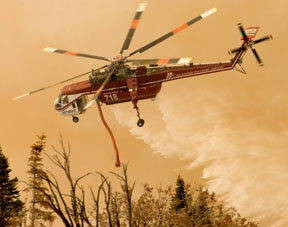Smoke Management
Overview
The information within these pages is offered by the Interagency Smoke Committee (SmoC). SmoC is chartered by the National Wildfire Coordinating Group (NWCG) to provide leadership, coordination and integration of air resource and fire management objectives.
Managers of wildland fire, whether responding to wildfires or planning and implementing prescribed fires, must understand the reasons and methods for minimizing negative impacts from smoke. Managers already know that protecting human life is the foremost priority in all aspects of wildland fire management (including smoke); protecting natural resources and personal property are secondary priorities. This website provides fire managers with information necessary for understanding the legal and operational aspects of smoke management.
The legal foundation of smoke management is the Clean Air Act which establishes primary (public health) and secondary (welfare and environmental quality) standards for controlling air pollution. The Act also requires the Environmental Protection Agency (EPA) to set National Ambient Air Quality Standards (NAAQS) to control pollution and protect public health, safety, and welfare. The Clean Air Act establishes state-level responsibilities for preventing and controlling air pollution. Many of the specific requirements for smoke management are therefore found in State Implementation Plans (SIP) and Smoke Management Programs (SMP). In addition to specific SIPs and SMPs, fire managers should be familiar with EPA’s Interim Air Quality Policy on Wildland and Prescribed Fire.
Emissions from wildland fires are subject to the laws, regulations, and policies at state and national levels because of the types of pollutants contained in smoke. The major components of smoke are water vapor and carbon dioxide. However, smoke also contains the pollutants carbon monoxide, nitrogen oxide, hydrocarbons, and particulate matter. Because of its very small size (similar to pollen), fine particulate matter can easily penetrate deep into lung tissue, causing severe respiratory and cardio-vascular disease. This pollutant also can significantly reduce visibility on highways by scattering and absorbing light, resulting in unsafe driving conditions. Therefore, particulate matter is the pollutant of primary concern for smoke management. In order to comply with the law, fire managers must understand how particulate matter affects public health, reduces visibility on highways and near airports, and impacts scenic vistas within Class I areas such as wilderness areas, national parks, and wildlife refuges.
Â
This website is organized to allow visitors to learn about:
- Laws, regulations, and policies at the federal, state, and agency levels.
- Preparing environmental analyses on smoke impacts to air quality under the National Environmental Policy Act (NEPA).
- Tools for managing smoke such as smoke dispersion models, weather and smoke forecasts, and monitoring equipment and methods.
- Publications and other links with important information on smoke management.
NWCG Smoke Committee Information Sheet
Smokepedia - Definitions and concepts in smoke management
2012 National Mobilization Guide
2012 "Red Book" and 2011 "Blue Book"
Sit Report and National Fire News
PIO Bulletin Board / Fire Season Podcasts
Join us on Twitter, Facebook,
You Tube, and Picasa:



